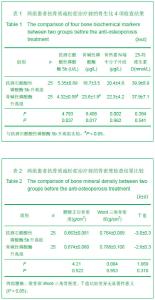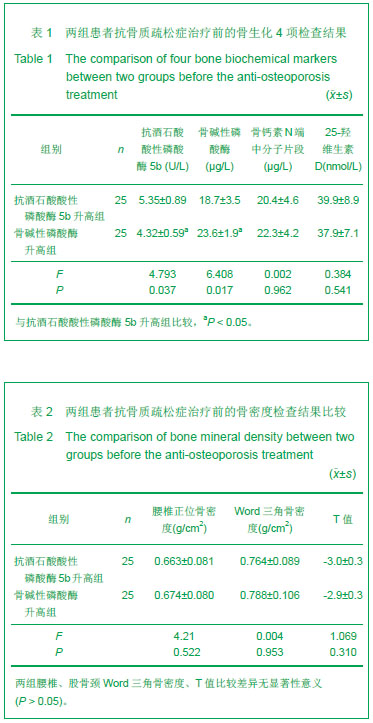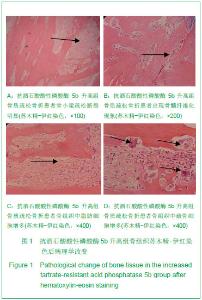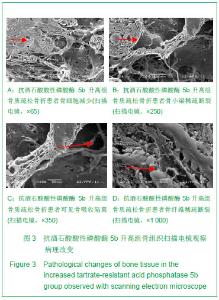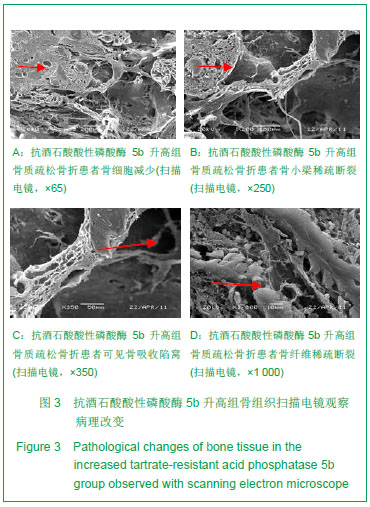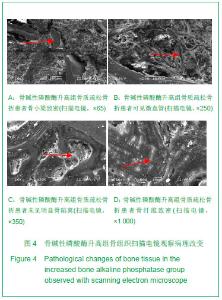Chinese Journal of Tissue Engineering Research ›› 2013, Vol. 17 ›› Issue (28): 5126-5132.doi: 10.3969/j.issn.2095-4344.2013.28.005
Previous Articles Next Articles
Basis of anti-osteoporosis drug application: Bone biochemical metabolic markers and bone histopathology
Yu Hua-wei, Wang Zhao-jie, Hu Xiao-jun, Zhao Jun-yan, Qi Xin-wen
- Department of Orthopedics, the Fifth Affiliated (Zhuhai) Hospital of Zunyi Medical University, Zhuhai 519100, Guangdong Province, China
-
Online:2013-07-09Published:2013-07-09 -
Contact:Wang Zhao-jie, M.D., Professor, Master’s supervisor, Department of Orthopedics, the Fifth Affiliated (Zhuhai) Hospital of Zunyi Medical University, Zhuhai 519100, Guangdong Province, China -
About author:Yu Hua-wei, Associate chief physician, Department of Orthopedics, the Fifth Affiliated (Zhuhai) Hospital of Zunyi Medical University, Zhuhai 519100, Guangdong Province, China huangnianfang@163.com -
Supported by:Key Medical Research of Zhuhai Health Bureau, No. 2011080*
CLC Number:
Cite this article
Yu Hua-wei, Wang Zhao-jie, Hu Xiao-jun, Zhao Jun-yan, Qi Xin-wen. Basis of anti-osteoporosis drug application: Bone biochemical metabolic markers and bone histopathology[J]. Chinese Journal of Tissue Engineering Research, 2013, 17(28): 5126-5132.
share this article
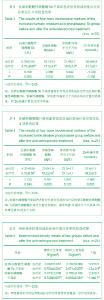
2.2 抗骨质疏松治疗后骨生化4项和骨密度 2.2.1 两组患者抗骨质疏松治疗6个月后骨生化4项检查结果 两组患者在抗骨质疏松治疗前、后TRACP 5b与BAP检测值差异均有显著性意义(P < 0.05),而骨钙素N端中分子片段(N-MID OC)和25-羟维生素D (25-OH-VD)检测值差异无显著性意义(P > 0.05)。这表明两组患者在进行针对性抗骨质疏松治疗后TRACP 5b与BAP在患者体内含量明显降低,而骨钙素N端中分子片段(N-MID OC)和25-羟维生素D(25-OH-VD)两组数值在治疗前、后改变不明显,见表3,4。 2.2.2 两组患者抗骨质疏松治疗6个月后骨密度检查结果 两组患者在抗骨质疏松治疗前、后腰椎和股骨颈Word三角骨密度差异有显著性意义(P < 0.05),治疗前、后T值检查结果差异有显著性意义(P < 0.05),证明患者抗骨质疏松治疗效果良好,见表5。"
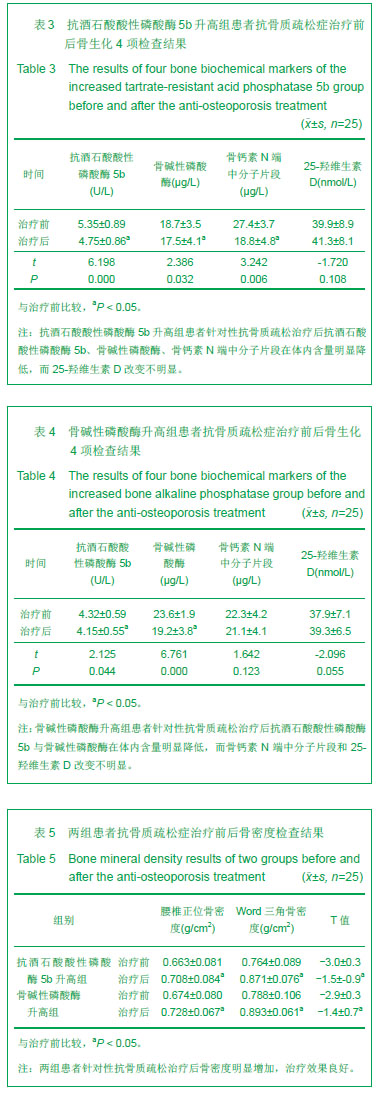
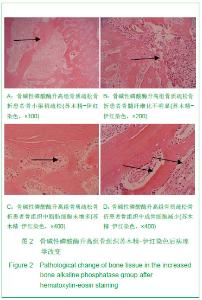
图2为BAP升高组患者骨组织病理切片苏木精-伊红染色普通光镜下检查放大100倍、200倍和400倍的图像,图像中显示:成骨细胞减少,未见有破骨细胞增多,骨小梁稀疏变细较TRACP 5b升高组为轻,纤维组织稍增生,结构无明显紊乱,间隙稍增大,无明显断裂,未见明显骨髓纤维化。 依据遵义医学院珠海校区中心实验室Mivnt图像分析系统,分别对病理切片苏木精-伊红染色普通光镜下放大100倍后进行图像采集分析:TRACP 5b升高组骨小梁/骨面积比值为0.284 52±0.024 87;BAP升高组骨小梁/骨面积比值0.343 26±0.034 08,经统计学分析,TRACP 5b升高组患者骨小梁/骨面积比值与BAP升高组骨小梁/骨面积比值差异有显著性意义(P < 0.05),表明TRACP 5b升高组骨小梁破坏较BAP升高组更明显。"

| [1]Abbott TA 3rd, Mucha L, Manfredonia D,et al.Efficient patient identification strategies for women with osteoporosis.J Clin Densitom. 1999;2(3):223-230.[2]Lin JT, Lane JM.Osteoporosis: a review.Clin Orthop Relat Res. 2004;(425):126-134. [3]陶若奇,魏进旺.骨质疏松性骨折的诊治及预防[J].中国现代外科学杂志,2009,6(4):209-213.[4]中华医学会骨质疏松和骨矿盐疾病分会. 原发性骨质疏松症诊疗指南(讨论稿) [J]. 中华全科医师杂志, 2006, 5(8): 455-457.[5]叶超群, 陈佑学, 纪树荣. 骨质疏松性骨折的危险因素及预测[J]. 中国康复医学杂志, 2007, 22(7): 660-662. [6]李险峰. 骨质疏松症的临床表现、检查及诊断[J]. 新医学, 2007, 38(1): 8-11.[7]Kanis JA.Assessment of fracture risk and its application to screening for postmenopausal osteoporosis: synopsis of a WHO report. WHO Study Group.Osteoporos Int.1994; 4(6): 368-381.[8]NIH Consensus Development Panel on Osteoporosis Prevention, Diagnosis, and Therapy.Osteoporosis prevention, diagnosis, and therapy.JAMA. 2001;285(6):785-795.[9]罗南萍,刘恒国,李金花,等. 老年男性代谢综合征患者骨密度与骨量、骨代谢物的关系[J].中国组织工程研究与临床康复, 2008, 12(7):1247-1250.[10]Fukunaga M, Sone T, Yoshikawa K. Diagnostic criteria of male osteoporosis.Clin Calcium. 2006;16(3):437-442.[11]杨伟民,邵斌.骨代谢生化指标与骨质疏松症[J]. 中国骨质疏松杂志,2004,10(1):118-120.[12]Blake GM, Fogelman I.The role of DXA bone density scans in the diagnosis and treatment of osteoporosis. Postgrad Med J. 2007;83(982):509-517.[13]杨凡,单咏梅,沈英,等. 骨生化标志物联合检测在骨质疏松症中的意义[J]. 检验医学, 2010, 25(10): 768-770.[14]Nishizawa Y, Nakamura T, Ohta H,et al.Guidelines for the use of biochemical markers of bone turnover in osteoporosis (2004).J Bone Miner Metab. 2005;23(2):97-104. [15]Delmas PD, Seeman E. Changes in bone mineral density explain little of the reduction in vertebral or nonvertebral fracture risk with anti-resorptive therapy. Bone. 2004; 34(4):599-604.[16]Kobayashi E, Masuda M, Nakayama R,et al.Reduced argininosuccinate synthetase is a predictive biomarker for the development of pulmonary metastasis in patients with osteosarcoma.Mol Cancer Ther. 2010;9(3):535-544. [17]Halleen JM, Alatalo SL, Janckila AJ,et al.Serum tartrate-resistant acid phosphatase 5b is a specific and sensitive marker of bone resorption.Clin Chem. 2001;47(3):597-600.[18]吴乃宝, 郭忠. 血清BALP、IL测定在骨质疏松症的应用评价[J].中国实验诊断学, 2006, 10(5): 559-560.[19]刘红,廖二元,伍贤平. 骨钙素与代谢性骨病[J]. 国外医学:内分泌学分册, 2004, 24(4): 239-240.[20]Holick MF.Vitamin D deficiency. N Engl J Med. 2007;357(3): 266-281. [21]Camozzi V, Tossi A, Simoni E,et al. Role of biochemical markers of bone remodeling in clinical practice.J Endocrinol Invest. 2007;30(6 Suppl):13-17.[22]Mountzios G, Terpos E, Syrigos K,et al. Markers of bone remodeling and skeletal morbidity in patients with solid tumors metastatic to the skeleton receiving the biphosphonate zoledronic acid.Transl Res. 2010;155(5):247-255.[23]喻晶,余学锋.骨代谢标志物和骨矿密度在骨质疏松症中的应用[J].临床内科杂志,2009,26(3):155-157.[24]Mochizuki Y. Bone and bone related biochemical examinations. Bone and collagen related metabolites. Tartrate-resistant acid phosphatase (TRACP).Clin Calcium. 2006;16(6):948-955.[25]肖恩,司良毅,孟萍.血清抗酒石酸酸性磷酸酶5b测定在老年人中的临床应用[J].重庆医学, 2008, 37(2): 159-163.[26]肖恩,孟萍.骨质疏松骨代谢生化指标的研究进展[J].中国骨质疏松杂志,2008,14(3):212-216.[27]张军芳,蒋飞霞,徐裔婷.骨代谢生化标志物与骨质疏松症研究进展[J]. 中国热带医学,2009,9(3):568-570.[28]Erem C, Tanakol R, Alagöl F,et al. Relationship of bone turnover parameters, endogenous hormones and vit D deficiency to hip fracture in elderly postmenopausal women. Int J Clin Pract. 2002;56(5):333-337. [29]Lee YH, Rho YH, Choi SJ,et al. Predictors of bone mineral density and osteoporosis in patients attending a rheumatology outpatient clinic.Rheumatol Int. 2003;23(2):67-69.[30]和田诚基,胡宜,李军. 骨代谢标志物和骨质疏松症[J]. 日本医学介绍, 2003, 24(2): 84-85.[31]金剑,肖忠革,金芝贵,等. 骨质疏松症的药物治疗概况[J].中国药师, 2007, 10(1): 69-71.[32]张亚,公瑞煜,石朝周.抑制骨吸收药物的现状及进展[J].国外医学:老年医学分册,2003,24(2):91-94.[33]Russell RG, Rogers MJ, Frith JC,et al. The pharmacology of bisphosphonates and new insights into their mechanisms of action.J Bone Miner Res. 1999;14 Suppl 2:53-65.[34]Chesnut CH 3rd, Silverman S, Andriano K,et al.A randomized trial of nasal spray salmon calcitonin in postmenopausal women with established osteoporosis: the prevent recurrence of osteoporotic fractures study. PROOF Study Group.Am J Med. 2000;109(4):267-276.[35]Neer RM, Arnaud CD, Zanchetta JR,et al. Effect of parathyroid hormone (1-34) on fractures and bone mineral density in postmenopausal women with osteoporosis. N Engl J Med. 2001;344(19):1434-1441.[36]Mundy G, Garrett R, Harris S,et al. Stimulation of bone formation in vitro and in rodents by statins.Science. 1999; 286(5446):1946-1949.[37]Karachalios T, Lyritis GP, Kaloudis J,et al. The effects of calcitonin on acute bone loss after pertrochanteric fractures. A prospective, randomised trial. J Bone Joint Surg Br. 2004; 86(3): 350-358. [38]张绪金,唐英华,刘忠厚.降钙索进展[J].中国骨质疏松杂志,2004, 10(1):96-97 .[39]李杰华,霍力为,陈允周,等.古欣肽骨肽注射液治疗骨质增生疗效观察[J].广东医学, 2008, 29(3):507-508.[40]Mihaljevi? I, Mudri D, Smoli? R,et al. Biochemical bone turnover markers: significance in patients with osteoporosis.Coll Antropol. 2009;33 Suppl 2:21-24. |
| [1] | Xu Feng, Kang Hui, Wei Tanjun, Xi Jintao. Biomechanical analysis of different fixation methods of pedicle screws for thoracolumbar fracture [J]. Chinese Journal of Tissue Engineering Research, 2021, 25(9): 1313-1317. |
| [2] | Zhang Chong, Liu Zhiang, Yao Shuaihui, Gao Junsheng, Jiang Yan, Zhang Lu. Safety and effectiveness of topical application of tranexamic acid to reduce drainage of elderly femoral neck fractures after total hip arthroplasty [J]. Chinese Journal of Tissue Engineering Research, 2021, 25(9): 1381-1386. |
| [3] | Chen Xinmin, Li Wenbiao, Xiong Kaikai, Xiong Xiaoyan, Zheng Liqin, Li Musheng, Zheng Yongze, Lin Ziling. Type A3.3 femoral intertrochanteric fracture with augmented proximal femoral nail anti-rotation in the elderly: finite element analysis of the optimal amount of bone cement [J]. Chinese Journal of Tissue Engineering Research, 2021, 25(9): 1404-1409. |
| [4] | Du Xiupeng, Yang Zhaohui. Effect of degree of initial deformity of impacted femoral neck fractures under 65 years of age on femoral neck shortening [J]. Chinese Journal of Tissue Engineering Research, 2021, 25(9): 1410-1416. |
| [5] | Zhang Chao, Lü Xin. Heterotopic ossification after acetabular fracture fixation: risk factors, prevention and treatment progress [J]. Chinese Journal of Tissue Engineering Research, 2021, 25(9): 1434-1439. |
| [6] | Zhou Jihui, Li Xinzhi, Zhou You, Huang Wei, Chen Wenyao. Multiple problems in the selection of implants for patellar fracture [J]. Chinese Journal of Tissue Engineering Research, 2021, 25(9): 1440-1445. |
| [7] | Wang Debin, Bi Zhenggang. Related problems in anatomy mechanics, injury characteristics, fixed repair and three-dimensional technology application for olecranon fracture-dislocations [J]. Chinese Journal of Tissue Engineering Research, 2021, 25(9): 1446-1451. |
| [8] | Hu Kai, Qiao Xiaohong, Zhang Yonghong, Wang Dong, Qin Sihe. Treatment of displaced intra-articular calcaneal fractures with cannulated screws and plates: a meta-analysis of 15 randomized controlled trials [J]. Chinese Journal of Tissue Engineering Research, 2021, 25(9): 1465-1470. |
| [9] | Tang Hui, Yao Zhihao, Luo Daowen, Peng Shuanglin, Yang Shuanglin, Wang Lang, Xiao Jingang. High fat and high sugar diet combined with streptozotocin to establish a rat model of type 2 diabetic osteoporosis [J]. Chinese Journal of Tissue Engineering Research, 2021, 25(8): 1207-1211. |
| [10] | Chen Jiming, Wu Xiaojing, Liu Tianfeng, Chen Haicong, Huang Chengshuo. Effects of silymarin on liver injury and bone metabolism induced by carbon tetrachloride in mice [J]. Chinese Journal of Tissue Engineering Research, 2021, 25(8): 1224-1228. |
| [11] | Li Zhongfeng, Chen Minghai, Fan Yinuo, Wei Qiushi, He Wei, Chen Zhenqiu. Mechanism of Yougui Yin for steroid-induced femoral head necrosis based on network pharmacology [J]. Chinese Journal of Tissue Engineering Research, 2021, 25(8): 1256-1263. |
| [12] | Zou Gang, Xu Zhi, Liu Ziming, Li Yuwan, Yang Jibin, Jin Ying, Zhang Jun, Ge Zhen, Liu Yi. Human acellular amniotic membrane scaffold promotes ligament differentiation of human amniotic mesenchymal stem cells modified by Scleraxis in vitro [J]. Chinese Journal of Tissue Engineering Research, 2021, 25(7): 1037-1044. |
| [13] | Hou Guangyuan, Zhang Jixue, Zhang Zhijun, Meng Xianghui, Duan Wen, Gao Weilu. Bone cement pedicle screw fixation and fusion in the treatment of degenerative spinal disease with osteoporosis: one-year follow-up [J]. Chinese Journal of Tissue Engineering Research, 2021, 25(6): 878-883. |
| [14] | He Li, Tian Wei, Xu Song, Zhao Xiaoyu, Miao Jun, Jia Jian. Factors influencing the efficacy of lumbopelvic internal fixation in the treatment of traumatic spinopelvic dissociation [J]. Chinese Journal of Tissue Engineering Research, 2021, 25(6): 884-889. |
| [15] | Yang Weiqiang, Ding Tong, Yang Weike, Jiang Zhengang. Combined variable stress plate internal fixation affects changes of bone histiocyte function and bone mineral density at the fractured end of goat femur [J]. Chinese Journal of Tissue Engineering Research, 2021, 25(6): 890-894. |
| Viewed | ||||||
|
Full text |
|
|||||
|
Abstract |
|
|||||
